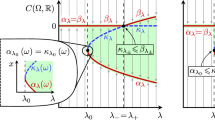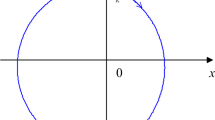Abstract
The structure of solutions to the nonlinear parametric programming problem with a one dimensional parameter is analyzed in terms of the bifurcation behavior of the curves of critical points and the persistence of minima along these curves. Changes in the structure of the solution occur at singularities of a nonlinear system of equations motivated by the Fritz John first-order necessary conditions. It has been shown that these singularities may be completely partitioned into seven distinct classes based upon the violation of one or more of the following: a complementarity condition, a constraint qualification, and the nonsingularity of the Hessian of the Lagrangian on a tangent space. To apply classical bifurcation techniques to these singularities, a further subdivision of each case is necessary. The structure of curves of critical points near singularities of lowest (zero) codimension within each case is analyzed, as well as the persistence of minima along curves emanating from these singularities. Bifurcation behavior is also investigated or discussed for many of the subcases giving rise to a codimension one singularity.
Similar content being viewed by others
References
B. Bank, J. Guddat, D. Klatte, B. Kummer and K. Tammer,Nonlinear Parametric Optimization (Birkhauser, Basel, 1983).
S.-N. Chow and J.K. Hale,Methods of Bifurcation Theory (Springer, New York, 1982).
M.G. Crandal and P.H. Rabinowitz, “Bifurcation from simple eigenvalues,”Journal of Functional Analysis 8 (1971) 321–340.
A.V. Fiacco,Introduction to Sensitivity and Stability Analysis in Nonlinear Programming (Academic Press, New York, 1983).
A.V. Fiacco, ed.,Sensitivity, Stability and Parametric Analysis, Mathematical Programming Study 21 (North Holland, Amsterdam, 1984).
G.H. Golub and C.F. Van Loan,Matrix Computations (The Johns Hopkins University Press, Baltimore, MD, 1983).
M. Golubitsky and D.G. Schaeffer,Singularities and Groups in Bifurcation Theory, Vol. 1 (Springer, New York, 1985).
C.D. Ha, “Application of degree theory in stability of the complementarity problem,” to appear in:Mathematics of Operations Research.
G. Iooss and D.D. Joseph,Elementary Stability and Bifurcation Theory (Springer, New York, 1980).
H.Th. Jongen, P. Jonker and F. Twilt, “On one-parameter families of sets defined by (in)equality constraints,”Nieuw Archief Voor Wiskunde 3 (1982) 307–322.
H.Th. Jongen, P. Jonker and F. Twilt,Nonlinear Optimization in R n:1. Morse Theory, Chebyshev Approximation (Peter Lang, New York, 1983).
H.Th. Jongen, P. Jonker and F. Twilt, “Critical sets in parametric optimization,”Mathematical Programming 34 (1984) 333–353.
H.Th. Jongen, P. Jonker and F. Twilt, “One-parameter families of optimization problems: Equality constraints,”Journal of Optimization Theory and Applications 48 (1986) 141–161.
T. Kato,Perturbation Theory for Linear Operators (Springer, New York, 1966).
H.B. Keller, “Numerical solution of bifurcation and nonlinear eigenvalue problems,” in: P.H. Rabinowitz, ed.,Applications of Bifurcation Theory (Academic Press, New York, 1977) pp. 359–384.
M. Kojima, “Strongly stable solutions in nonlinear programs,” in: S.M. Robinson, ed.,Analysis and Computation of Fixed Points (Academic Press, New York, 1980) pp. 93–138.
M. Kojima and R. Hirabayashi, “Continuous deformation of nonlinear programs,” in:Mathematical Programming Study 21 (1984) 150–198.
O.L. Mangasarian and S. Fromovitz, “The Fritz John necessary optimality conditions in the presence of equality and inequality constraints,”Journal of Mathematical Analysis and Applications 17 (1967) 37–47.
A.B. Poore and C.A. Tiahrt, “Bifurcation problems in nonlinear parametric programming,”Mathematical Programming 39 (1987) 189–205.
S.M. Robinson, “Stability theory for systems of inequalities, part II,”SIAM Journal on Numerical Analysis 13 (1976) 497–513.
S.M. Robinson, “Strongly regular generalized equations,”Mathematics of Operations Research 5 (1980) 43–62.
Y. Sawaragi, H. Nakayama and T. Tanino,Theory of Multiobjective Optimization (Academic Press, New York, 1985).
S. Schecter, “Structure of the first-order solution set of a class of nonlinear programs with parameters,”Mathematical Programming 34 (1986) 84–110.
D. Seirsma, “Singularities of functions on boundaries, corners, etc.,”Quarterly Journal of Mathematics, Oxford 32 (1981) 119–127.
C.A. Tiahrt, “Nonlinear parametric programming: Critical point bifurcation and persistence of minima,” Ph.D. Thesis, Colorado State University (Fort Collins, CO, 1986).
Author information
Authors and Affiliations
Additional information
This work was supported by the National Science Foundation through NSF Grants DMS-85-10201 and DMS-87-04679 and by the Air Force Office of Scientific Research through grant number AFOSR-88-0059.
Rights and permissions
About this article
Cite this article
Tiahrt, C.A., Poore, A.B. A bifurcation analysis of the nonlinear parametric programming problem. Mathematical Programming 47, 117–141 (1990). https://doi.org/10.1007/BF01580856
Received:
Revised:
Issue Date:
DOI: https://doi.org/10.1007/BF01580856




